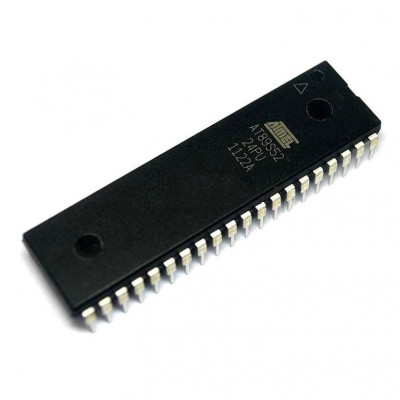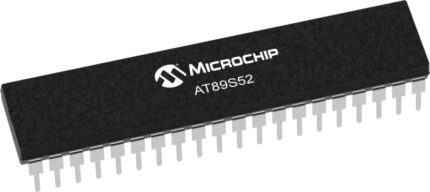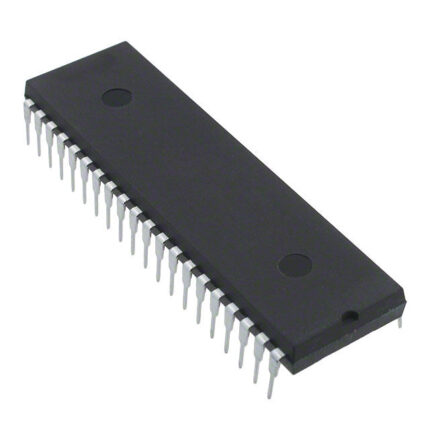AT89S51 MICROCONTROLLER
AT89S52 MICROCONTROLLER
Atmel AT89S52 Microcontroller high-performance CMOS 8-bit microcontroller
The Atmel AT89S52 Microcontroller or commonly known as AT89S52 is a low-power, high-performance CMOS 8-bit microcontroller with 8K bytes of in-system programmable Flash memory. The device is manufactured using Atmel?s high-density nonvolatile memory technology and is compatible with the industry-standard 80C51 instruction set and pinout. The on-chip Flash allows the program memory to be reprogrammed in-system or by a conventional nonvolatile memory programmer. By combining a versatile 8-bit CPU with in-system programmable Flash on a monolithic chip, the Atmel AT89S52 is a powerful microcontroller which provides a highly-flexible and cost-effective solution to many embedded control applications. Program Any IC, Micro-Controller | AT89S52, AT89S51, AT89C51,AT89C52 | Universal ISP Programmer :https://www.youtube.com/watch?v=Zhsktt0S1FoAT89S8252 MICROCONTROLLER
AT89S8253 MICROCONTROLLER
ATMEGA128-16AN
8-bit Microcontrollers - MCU AVR,128KB FLASH 4KB EE,4KB SRAM,5V
Features
? High-performance, Low-power Atmel?AVR?8-bit Microcontroller
? Advanced RISC Architecture
? 133 Powerful Instructions ? Most Single Clock Cycle Execution
? 32 x 8 General Purpose Working Registers Peripheral Control Registers
? Fully Static Operation
? Up to 16MIPS Throughput at 16MHz
? On-chip 2-cycle Multiplier
? High Endurance Non-volatile Memory segments
? 128Kbytes of In-System Self-programmable Flash program memory
? 4Kbytes EEPROM
? 4Kbytes Internal SRAM
? Write/Erase cycles: 10,000 Flash/100,000 EEPROM
? Data retention: 20 years at 85?C/100 years at 25?C(1)
? Optional Boot Code Section with Independent Lock Bits
In-System Programming by On-chip Boot Program
True Read-While-Write Operation
? Up to 64Kbytes Optional External Memory Space
? Programming Lock for Software Security
? SPI Interface for In-System Programming
? QTouch? library support
? Capacitive touch buttons, sliders and wheels
? QTouch and QMatrix acquisition
? Up to 64 sense channels
? JTAG (IEEE std. 1149.1 Compliant) Interface
? Boundary-scan Capabilities According to the JTAG Standard
? Extensive On-chip Debug Support
? Programming of Flash, EEPROM, Fuses and Lock Bits through the JTAG Interface
? Peripheral Features
? Two 8-bit Timer/Counters with Separate Prescalers and Compare Modes
? Two Expanded 16-bit Timer/Counters with Separate Prescaler, Compare Mode and Capture
Mode
? Real Time Counter with Separate Oscillator
? Two 8-bit PWM Channels
? 6 PWM Channels with Programmable Resolution from 2 to 16 Bits
? Output Compare Modulator
? 8-channel, 10-bit ADC
8 Single-ended Channels
7 Differential Channels
2 Differential Channels with Programmable Gain at 1x, 10x, or 200x
? Byte-oriented Two-wire Serial Interface
? Dual Programmable Serial USARTs
? Master/Slave SPI Serial Interface
? Programmable Watchdog Timer with On-chip Oscillator
? On-chip Analog Comparator
? Special Microcontroller Features
? Power-on Reset and Programmable Brown-out Detection
? Internal Calibrated RC Oscillator
? External and Internal Interrupt Sources
? Six Sleep Modes: Idle, ADC Noise Reduction, Power-save, Power-down, Standby, and
Extended Standby
? Software Selectable Clock Frequency
? ATmega103 Compatibility Mode Selected by a Fuse
? Global Pull-up Disable
? I/O and Packages
? 53 Programmable I/O Lines
? 64-lead TQFP and 64-pad QFN/MLF
? Operating Voltages
? 2.7 - 5.5V ATmega128L
? 4.5 - 5.5V ATmega128
? Speed Grades
? 0 - 8MHz ATmega128L
? 0 - 16MHz ATmega128
ATMEGA128-16ANR
8-bit Atmel Microcontroller with 128KBytes In-System Programmable Flash
Features
? High-performance, Low-power Atmel?AVR?8-bit Microcontroller
? Advanced RISC Architecture
? 133 Powerful Instructions ? Most Single Clock Cycle Execution
? 32 x 8 General Purpose Working Registers Peripheral Control Registers
? Fully Static Operation
? Up to 16MIPS Throughput at 16MHz
? On-chip 2-cycle Multiplier
? High Endurance Non-volatile Memory segments
? 128Kbytes of In-System Self-programmable Flash program memory
? 4Kbytes EEPROM
? 4Kbytes Internal SRAM
? Write/Erase cycles: 10,000 Flash/100,000 EEPROM
? Data retention: 20 years at 85?C/100 years at 25?C(1)
? Optional Boot Code Section with Independent Lock Bits
In-System Programming by On-chip Boot Program
True Read-While-Write Operation
? Up to 64Kbytes Optional External Memory Space
? Programming Lock for Software Security
? SPI Interface for In-System Programming
? QTouch? library support
? Capacitive touch buttons, sliders and wheels
? QTouch and QMatrix acquisition
? Up to 64 sense channels
? JTAG (IEEE std. 1149.1 Compliant) Interface
? Boundary-scan Capabilities According to the JTAG Standard
? Extensive On-chip Debug Support
? Programming of Flash, EEPROM, Fuses and Lock Bits through the JTAG Interface
ATMEGA128-16AU
8-bit Microcontrollers - MCU 16MHZ, TQFP, IND TEMP, GREEN
Features
? High-performance, Low-power Atmel?AVR?8-bit Microcontroller
? Advanced RISC Architecture
? 133 Powerful Instructions ? Most Single Clock Cycle Execution
? 32 x 8 General Purpose Working Registers Peripheral Control Registers
? Fully Static Operation
? Up to 16MIPS Throughput at 16MHz
? On-chip 2-cycle Multiplier
? High Endurance Non-volatile Memory segments
? 128Kbytes of In-System Self-programmable Flash program memory
? 4Kbytes EEPROM
? 4Kbytes Internal SRAM
? Write/Erase cycles: 10,000 Flash/100,000 EEPROM
? Data retention: 20 years at 85?C/100 years at 25?C(1)
? Optional Boot Code Section with Independent Lock Bits
In-System Programming by On-chip Boot Program
True Read-While-Write Operation
? Up to 64Kbytes Optional External Memory Space
? Programming Lock for Software Security
? SPI Interface for In-System Programming
? QTouch? library support
? Capacitive touch buttons, sliders and wheels
? QTouch and QMatrix acquisition
? Up to 64 sense channels
? JTAG (IEEE std. 1149.1 Compliant) Interface
? Boundary-scan Capabilities According to the JTAG Standard
? Extensive On-chip Debug Support
? Programming of Flash, EEPROM, Fuses and Lock Bits through the JTAG Interface
? Peripheral Features
? Two 8-bit Timer/Counters with Separate Prescalers and Compare Modes
? Two Expanded 16-bit Timer/Counters with Separate Prescaler, Compare Mode and Capture
Mode
? Real Time Counter with Separate Oscillator
? Two 8-bit PWM Channels
? 6 PWM Channels with Programmable Resolution from 2 to 16 Bits
? Output Compare Modulator
? 8-channel, 10-bit ADC
8 Single-ended Channels
7 Differential Channels
2 Differential Channels with Programmable Gain at 1x, 10x, or 200x
? Byte-oriented Two-wire Serial Interface
? Dual Programmable Serial USARTs
? Master/Slave SPI Serial Interface
? Programmable Watchdog Timer with On-chip Oscillator
? On-chip Analog Comparator
? Special Microcontroller Features
? Power-on Reset and Programmable Brown-out Detection
? Internal Calibrated RC Oscillator
? External and Internal Interrupt Sources
? Six Sleep Modes: Idle, ADC Noise Reduction, Power-save, Power-down, Standby, and
Extended Standby
? Software Selectable Clock Frequency
? ATmega103 Compatibility Mode Selected by a Fuse
? Global Pull-up Disable
? I/O and Packages
? 53 Programmable I/O Lines
? 64-lead TQFP and 64-pad QFN/MLF
? Operating Voltages
? 2.7 - 5.5V ATmega128L
? 4.5 - 5.5V ATmega128
? Speed Grades
? 0 - 8MHz ATmega128L
? 0 - 16MHz ATmega128
ATMEGA128-16AUR
8-bit Microcontrollers - MCU AVR 128KB FLASH 4KB EE 4KB SRAM,5V
? Peripheral Features
? Two 8-bit Timer/Counters with Separate Prescalers and Compare Modes
? Two Expanded 16-bit Timer/Counters with Separate Prescaler, Compare Mode and Capture
Mode
? Real Time Counter with Separate Oscillator
? Two 8-bit PWM Channels
? 6 PWM Channels with Programmable Resolution from 2 to 16 Bits
? Output Compare Modulator
? 8-channel, 10-bit ADC
8 Single-ended Channels
7 Differential Channels
2 Differential Channels with Programmable Gain at 1x, 10x, or 200x
? Byte-oriented Two-wire Serial Interface
? Dual Programmable Serial USARTs
? Master/Slave SPI Serial Interface
? Programmable Watchdog Timer with On-chip Oscillator
? On-chip Analog Comparator
? Special Microcontroller Features
? Power-on Reset and Programmable Brown-out Detection
? Internal Calibrated RC Oscillator
? External and Internal Interrupt Sources
? Six Sleep Modes: Idle, ADC Noise Reduction, Power-save, Power-down, Standby, and
Extended Standby
? Software Selectable Clock Frequency
? ATmega103 Compatibility Mode Selected by a Fuse
? Global Pull-up Disable
? I/O and Packages
? 53 Programmable I/O Lines
? 64-lead TQFP and 64-pad QFN/MLF
? Operating Voltages
? 2.7 - 5.5V ATmega128L
? 4.5 - 5.5V ATmega128
? Speed Grades
? 0 - 8MHz ATmega128L
? 0 - 16MHz ATmega128
ATMEGA128-16MNR
8-bit Atmel Microcontroller with 128KBytes In-System Programmable Flash
Features
? High-performance, Low-power Atmel?AVR?8-bit Microcontroller
? Advanced RISC Architecture
? 133 Powerful Instructions ? Most Single Clock Cycle Execution
? 32 x 8 General Purpose Working Registers Peripheral Control Registers
? Fully Static Operation
? Up to 16MIPS Throughput at 16MHz
? On-chip 2-cycle Multiplier
? High Endurance Non-volatile Memory segments
? 128Kbytes of In-System Self-programmable Flash program memory
? 4Kbytes EEPROM
? 4Kbytes Internal SRAM
? Write/Erase cycles: 10,000 Flash/100,000 EEPROM
? Data retention: 20 years at 85?C/100 years at 25?C(1)
? Optional Boot Code Section with Independent Lock Bits
In-System Programming by On-chip Boot Program
True Read-While-Write Operation
? Up to 64Kbytes Optional External Memory Space
? Programming Lock for Software Security
? SPI Interface for In-System Programming
? QTouch? library support
? Capacitive touch buttons, sliders and wheels
? QTouch and QMatrix acquisition
? Up to 64 sense channels
? JTAG (IEEE std. 1149.1 Compliant) Interface
? Boundary-scan Capabilities According to the JTAG Standard
? Extensive On-chip Debug Support
? Programming of Flash, EEPROM, Fuses and Lock Bits through the JTAG Interface














